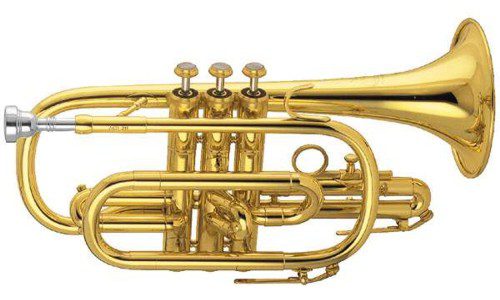
Cornet – the undeservedly forgotten hero of the brass band
A cornet (cornet-a-piston) is a brass instrument. It looks very impressive and its copper sides shine favorably against the background of other instruments in the orchestra. These days, his glory, unfortunately, is a thing of the past.

The cornet is a direct descendant of the post horn. Interestingly, the horn was made of wood, but it was always classified as a brass instrument. The horn has a very rich history; Jewish priests blew it so that the walls of Jericho would fall; in the Middle Ages, knights performed their feats to the sound of horns.
A distinction should be made between the modern cornet-a-piston instrument, which is made of copper, and its predecessor, the wooden cornet (zinc). Zink is the German name for cornet. Now few people know, but from the fifteenth to the mid-seventeenth centuries the cornet was a very common musical instrument in Europe. But without a cornet it is impossible to perform a large layer of musical works of the seventeenth and eighteenth centuries. City festivals during the Renaissance were unthinkable without cornets. And at the end of the sixteenth century, the cornet (zinc) in Italy became a masterful solo musical instrument.
The names of two famous zinc playing virtuosos of that time, Giovanni Bossano and Claudio Monteverdi, have reached us. The spread of the violin and the growing popularity of violin playing in the seventeenth century caused the cornet to gradually lose its position as a solo instrument. His dominant position lasted longest in northern Europe, where his last solo compositions dated back to the second half of the eighteenth century. By the beginning of the nineteenth century, the cornet (zinc) had completely lost its relevance. Nowadays it is used in the performance of ancient folk music.
The cornet-a-piston appeared in Paris in 1830. Sigismund Stölzel is considered his father-inventor. This new instrument was equipped with two valves. In 1869, mass training in playing the cornet began, and courses began at the Paris Conservatory. At the origins was the first professor, a very famous cornetist, a virtuoso of his craft, Jean Baptiste Arban. By the end of the nineteenth century, the cornet-a-piston was at the peak of its popularity, and on this wave it appeared in the Russian Empire.
Nikolai Pavlovich was the first Russian Tsar to play several types of wind instruments. He owned a flute, horn, cornet and cornet-a-piston, but Nicholas I himself jokingly called all his instruments simply “trumpet.” Contemporaries repeatedly mentioned his outstanding musical abilities. He even composed a little, mostly military marches. Nikolai Pavlovich demonstrated his musical achievements at chamber concerts, as was customary at that time. The concerts were held in the Winter Palace, and, as a rule, there were no extra people at them.
The tsar did not have the time or physical ability to regularly devote time to music lessons, so he obliged A.F. Lvov, the author of the hymn “God Save the Tsar,” to come on the eve of the performance for a rehearsal. Especially for Tsar Nikolai Pavlovich A.F. Lvov composed the game on cornet-a-piston. In fiction, there is also often a mention of the cornet-a-piston: A. Tolstoy “Gloomy Morning”, A. Chekhov “Sakhalin Island”, M. Gorky “Spectators”.
Все дело было в его превосходстве над другими медными в исполнении музыки, требующей большей беглости. Корнет обладает большой технической подвижностью и ярким, выразительным звучанием. Такому инструменту в первую очередь дают «нарисовать» перед слушателями мелодию произведения, композиторы доверяли корнету сольные партии.
The trumpet was an honored guest at the court of monarchs and in wars. The cornet traces its origins back to the horns of hunters and postmen, with which they gave signals. There is an opinion among connoisseurs and professionals that the cornet is not a virtuoso-sounding trumpet, but a small, gentle horn.
There is one more instrument that I would like to talk about – this is the echo – cornet. It gained popularity in England during the reign of Queen Victoria, as well as in America. Its unusual feature is the presence of not one, but two bells. The cornetist, switching to another trumpet while playing, created the illusion of a muffled sound. The second valve helped him with this. This option is useful for creating an echo effect. The instrument gained wide popularity; works were created for the echo cornet, which revealed all the beauty of its sound. This ancient music is still performed by cornetists abroad on such a rare instrument (for example, “Alpine Echo”). These echo cornets were manufactured in limited quantities, the main supplier being Booseys & Hawkes. Now there are similar instruments made in India, but they are not made well, so when choosing an echo cornet, experienced performers prefer old copies.
The cornet resembles a trumpet, but its tube is shorter and wider and has pistons rather than valves. The body of the cornet is a cone-shaped pipe with a wide recess. At the base of the pipe there is a mouthpiece that produces sound. In a cornet-a-piston, the piston mechanism consists of buttons. The keys are at the same height as the mouthpiece, at the top of the structure. This musical instrument is very similar to the trumpet, but there are differences.
The undoubted advantage of the cornet-a-piston is its size – a little more than half a meter. Its short length is very convenient to use.
In the generally accepted classification, the cornet-a-piston is classified as an aerophone, which means that the sounds in it are produced by vibrating air masses. The musician blows air, and it, accumulating in the middle of the body, begins oscillatory movements. This is where the unique sound of the cornet originates. At the same time, the tonal range of this small wind instrument is wide and rich. He can play up to three octaves, which allows him to play not only standard programs that are classics, but also enrich melodies through improvisation. The cornet is a mid-tone instrument. The sound of the trumpet used to be heavy and inflexible, but the cornet’s barrel had more turns and sounded softer.
The velvety timbre of the cornet-a-piston is heard only in the first octave; in the lower register it becomes painful and insidious. Moving to the second octave, the sound changes to a sharper, more arrogant and sonorous one. These emotionally charged sounds of the cornet were beautifully used in their works by Hector Berlioz, Pyotr Ilyich Tchaikovsky and Georges Bizet.
The cornet-a-piston was also loved by jazz performers, and not a single jazz band could do without it. Famed jazz lovers of the cornet included Louis Daniel Armstrong and Joseph “King” Oliver.
В прошлом веке были улучшены конструкции труб и трубачи усовершенствовали свое профессиональные навыки, что удачно ликвидировало проблему отсутствия скорости и некрасочного звучания. После этого корнет-а-пистоны совсем исчезли из оркестров. В наши дни оркестровые партии, написанные для корнетов, исполняют на трубах, хотя иногда можно услышать и первоначальное звучание.


Watch this video on YouTube




